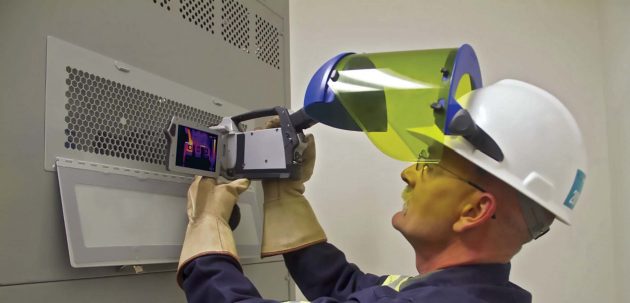
Full load EMSD for safer maintenance inspections
By Steve Gahbauer
Facilities Maintenance Industry Innovation & Technology MRO Manufacturing maintenance manufacturing TechnologySystems determine the condition of electrical distribution assets.

Inspecting with infrared thermology. PHOTO: IRSS
Inspection and surveillance equipment yields its most valuable results when applied to electrical distribution equipment operating under full load conditions. But doing so while working within CSA Z462 guidelines can be challenging because the surveillance equipment can endanger maintenance crews. The equipment normally requires direct access to energized components inside an electrical system, which means panels have to be open. Electrical maintenance surveillance device (EMSD) technologies don’t require panels to be open.
A case study from an Ontario beverage bottling facility and presented at the 2018 MainTrain maintenance conference in Ottawa demonstrated how EMSD is easily retrofitted onto existing distribution equipment to become the nexus for an electrical infrastructure reliability program. The session was presented by Rudy Wodrich, vice-president of engineering services at IRISS Inc. in Bradenton, Fla., and Scott Thornton, business development manager for DTM Consulting Services Inc. in St. Thomas, Ont., a specialist in critical asset surveillance technologies (CAST).
Electrical maintenance surveillance devices fall into three categories: windows, ports and online monitoring. Windows allow inspection in the visual, ultraviolet and/or infrared spectrum. They must be properly sized and allow the inspector to “see” target inspection points, which are typically cable terminations, bus bar joints and critical current-carrying components that are equipment-specific.
It was the windows category that one of North America’s leading bottled water companies applied to make maintenance inspections safe for its crews.
The primary goal was to define cost-effective, consistent maintenance processes by adopting the technologies to support and sustain processes.
Thornton was engaged to provide recommendations for placement, sizing and type of infrared windows to be installed. After an initial site survey, DTM recommended the IRISS CAP-CT series in various sizes. CAP-CT series is a NEMA 4/IP65-rated IR window suited for indoor applications. A reliability and maintenance policy was developed that includes a three- to five-year improvement plan. This policy was then communicated to all employees.
The company outlined all essential elements and stressed the importance of key performance indicators aligned with reliability-centred maintenance (RCM) and reliability-based maintenance (RBM) programs for overall plant safety. It subsequently determined IRISS transparent polymer infrared windows would provide a safer method for conducting standards-compliant inspections.
The reliability team decided on large format windows for main switchgear bus connections, main breaker connections and fused switches to find hot spots through the IR windows. As a result, more frequent inspections of energized equipment could be performed for routine maintenance. The closed-panel inspections didn’t require the elevated levels of personal protective equipment (PPE) mandated by NFPA 70E and Z462, thus reducing time and inspection costs.
Thermal imaging was not new to the maintenance and reliability team. Its members had previously retrofitted some equipment with traditional round calcium fluoride windows. However, it was determined a transparent polymer infrared window available in various large formatted sizes would provide both visual and thermal inspection, thus fewer units were needed. With the infrared windows in place, there was no need to remove panels or for personnel to wear increased levels of PPE. Inspections could be performed more often and on electrical equipment that had previously been impossible to inspect because of arc flash incident energy.
The bottled water company has proceeded with implementation of the IRISS infrared window solutions at 29 of its sites in North America.
Steve Gahbauer is an engineer, a Toronto-based business writer and a regular contributing editor. E-mail gahbauer55@gmail.com.
This article appeared in the October 2019 print edition of PLANT Magazine.
